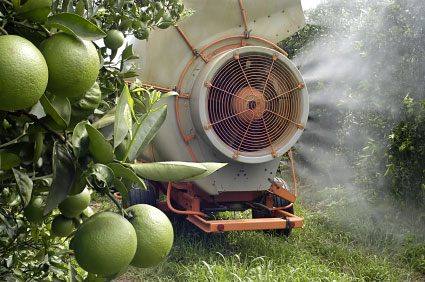 Truck spraying pesticides.Last week, I was shopping at a Berkeley grocery store with a friend visiting from another country. She wanted to buy blueberries for her two toddlers, and grabbed a big carton on sale for just $2. Inwardly, I winced, and I couldn’t help myself — I blurted out, “Um, blueberries are on the Environmental Working Group’s Dirty Dozen list for pesticide residues. The organic section’s over here … “
Truck spraying pesticides.Last week, I was shopping at a Berkeley grocery store with a friend visiting from another country. She wanted to buy blueberries for her two toddlers, and grabbed a big carton on sale for just $2. Inwardly, I winced, and I couldn’t help myself — I blurted out, “Um, blueberries are on the Environmental Working Group’s Dirty Dozen list for pesticide residues. The organic section’s over here … “
Over in the organic section, she was appalled. “These are three times as expensive!”
I tried to explain. “The sweeter the fruit, the harder it is to grow organically, to protect it from pests. And the more conventionally grown fruit peel the kids eat, as in small fruits like strawberries and blueberries, well, the more pesticides they’re ingesting.” (Grist’s Tom Laskawy reported on the latest research about exposure levels from fruit.)
My friend decided that her kids ate blueberries just twice a year, and she was OK with the risk from the $2 box.
As my daughter doesn’t yet eat food, I haven’t had to make those painful calculations. Both of us are fortunate. We have choices about what to feed our kids. What about the parents of kids growing up breathing these same pesticides? They’re not so lucky.
A new study, published last week in the journal Environmental Health Perspectives, looked at the effects of both prenatal and childhood exposure to organophosphate pesticides — of which 73 million pounds are applied each year in the U.S. — and found yet another link to attention deficit hyperactivity disorder. Not surprisingly, children living in agricultural areas are even more at risk.
UC Berkeley researchers have been studying more than 300 Mexican-American children living in California’s Salinas Valley, aka America’s “Lettuce Bowl.” They tested for levels of pesticide metabolites in urine in pregnant mothers, their newborns, and at 2 years old. The findings? Each tenfold increase in pesticide levels in the mothers’ urine was associated with a fivefold increase in attention problems, and boys had it worse than girls.
 Kids playing at the Grayson Charter School in Clifornia’s Central Valley, surrounded on three sides by heavily sprayed almond orchards.(Elanor Starmer)A post that Grist contributor Elanor Starmer wrote for the Ethicurean about her 2008 visit to an pesticide-smothered agricultural community in California’s Central Valley has stuck with me:
Kids playing at the Grayson Charter School in Clifornia’s Central Valley, surrounded on three sides by heavily sprayed almond orchards.(Elanor Starmer)A post that Grist contributor Elanor Starmer wrote for the Ethicurean about her 2008 visit to an pesticide-smothered agricultural community in California’s Central Valley has stuck with me:
The realities of industrial agriculture are out of sight for most of us, and yet we consume the fruits of the labor of farmworker communities. They bear the burden of chronic pesticide exposure and the long-term health impacts that stem from it, including asthma, developmental disorders, cancer, Parkinson’s, and autism.
The picture above right is from her trip. The children playing on the swings are surrounded by almond orchards regularly sprayed with chlorpyrifos, an organophosphate pesticide.
Wouldn’t it be nice if consumers weren’t the ones stuck having to perform that complex emotional calculus between household finances and the health of not only your child, but those living in the areas where the pesticide-laden fruit you’re contemplating was grown? If perhaps chlorpyrifos, which has been slated for phaseout, were just banned?
Get off your ass alert: If you’d like to get more involved beyond voting with your wallet, the groups Beyond Pesticides, Californians for Pesticide Reform, and Pesticide Action Network North America are all great resources. PANNA has a link and phone numbers to urge your representative to co-sponsor the Toxic Chemical Safety Act (HR 5820), recently introduced by Representatives Bobby Rush and Henry Waxman, which would overhaul America’s outdated chemical policies, including adding strong language to prioritize action on persistent, bioaccumulative, toxic chemicals.



